Before I hit the mountain, I always make sure that every piece of my gear is perfect. That includes my socks.
While you might think that choosing the right socks isn’t worth the effort, true experts know that they can make a serious difference. After all, your feet are probably the most important part of your body when it comes to skiing.
If your feet don’t feel quite right, you’re not going to reach your full potential. And if you’re not reaching your full potential, you’re probably not having much fun.
Approach this tiny detail with just an ounce of care and consideration, and you might be surprised at how much your skiing improves!
But are socks really that important?
And perhaps most importantly:
How can you find the best ski socks available this winter?
We’re glad you asked…
Product
Details
Best for Sore Shins
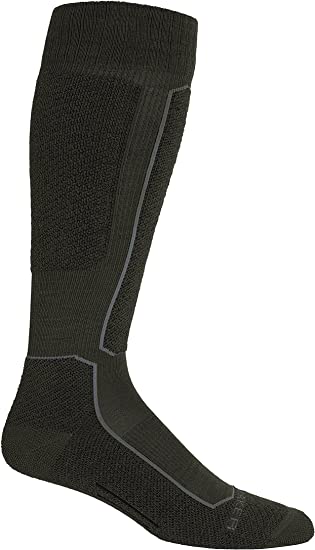
Icebreaker Ski+ Light OTC Socks
- Manufacturer:Icebreaker
- Fabric:Merin Wool, Nylon,Lycra
Solid Choice for Female

Smartwool Ski Full Cushion Socks
- Manufacturer:Smartwool
- Fabric:100% Wool
Toughest Socks Ever
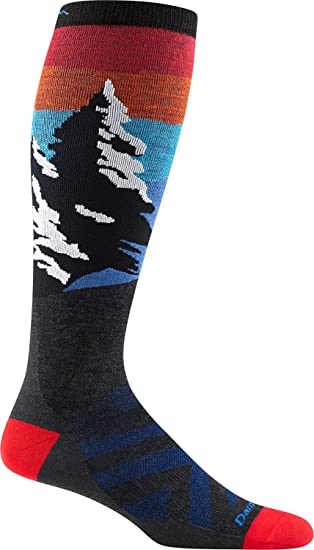
Darn Tough Solstice Lightweight Socks
- Manufacturer:Darn Tough
- Fabric:Spandex,Nylon,Merino Wool
Best Cushioning

Smartwool Ski Targeted Cushion Socks
- Manufacturer:Smartwool
- Fabric:Merino Wool
Best Overall
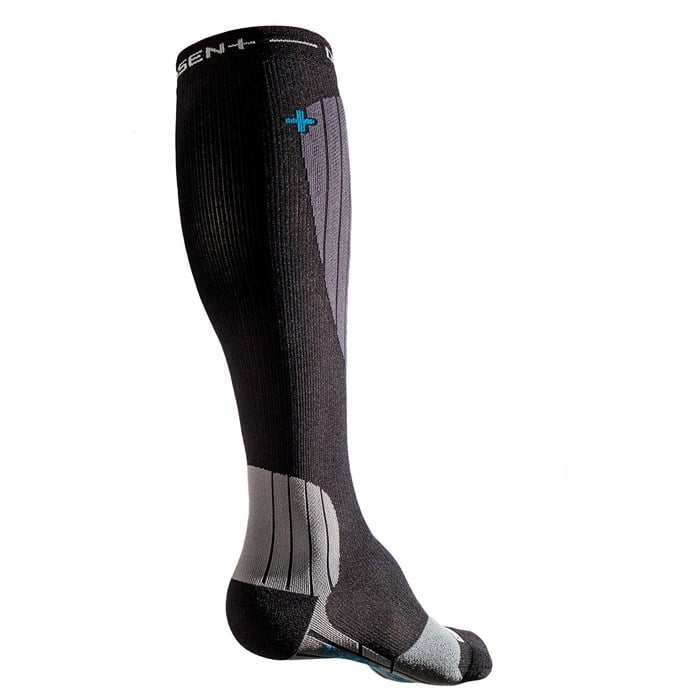
Dissent GFX Compression Hybrid Socks
- Manufacturer:Dissent
- Fabric: Engineered Technical Yarns
Best Budget Sock
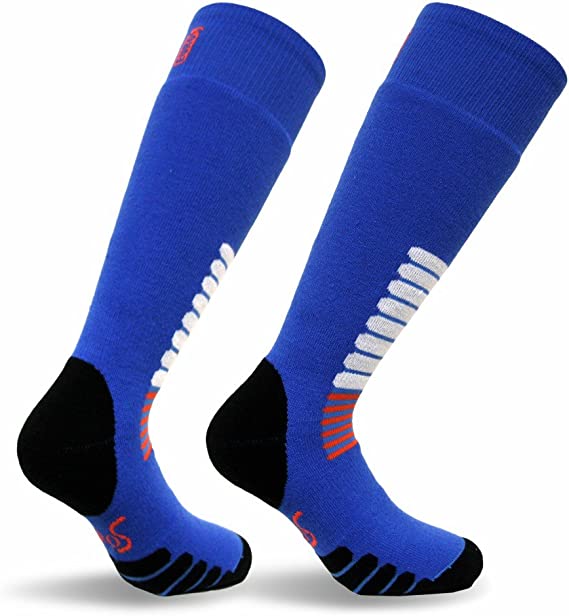
EURO Socks Ski Zone Socks
- Manufacturer:Eurosock
- Fabric:100% Other Fibers
For Pro Skiers
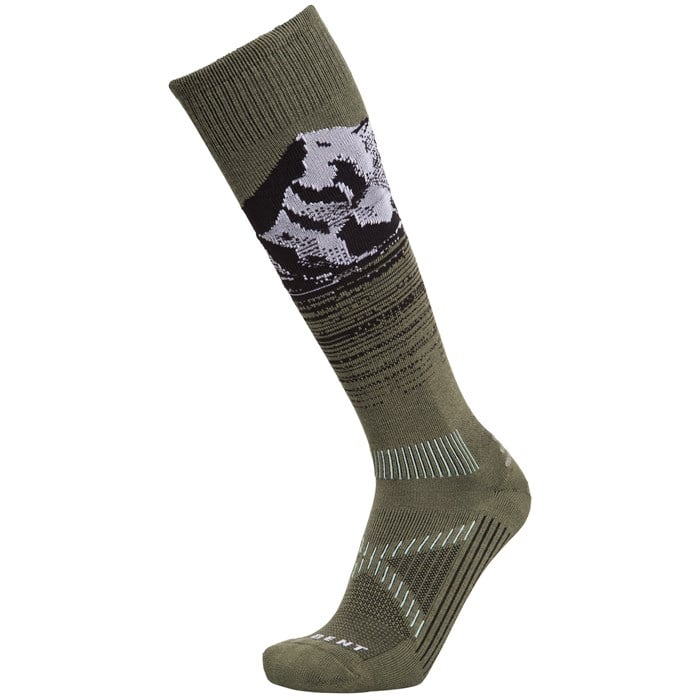
Le Bent Le Send Pro Socks
- Manufacturer:Le Bent
- Fabric:Merino wool and Rayon
Best Compression Socks
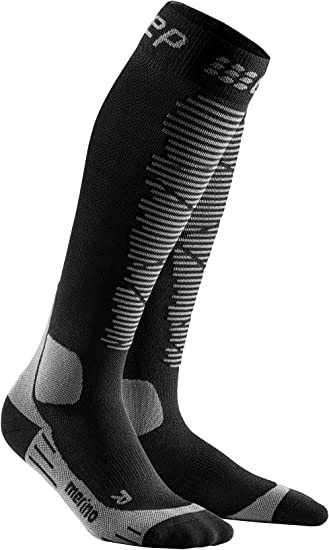
CEP Ski Merino Tall Compression Socks
- Manufacturer:CEP
- Fabric:Wool
Best Value

Wigwam Snow Sirocco Ski Sock
- Manufacturer:Wigwam Men’s Socks
- Fabric:Wool,Stretch Nylon
9 Best Ski Socks Available Today
With utmost care and intense deliberation, this list has been compiled to outline the best of the best! Let’s dive straight into the best ski socks available on the market today!
1. Icebreaker Ski+ Light OTC Socks
The Icebreaker Ski+ Light OTC Sock is a solid option for any serious skier.
With moisture-wicking merino wool, your feet will stay warm and dry even after hours of skiing. When I tested these bad boys, I noticed no moisture whatsoever – and the lack of odor was a nice bonus.
This ski sock also claims to have “strategic ventilation,” although I never really figured out what that meant exactly, except that it provides airflow when and where you need it!
One major plus was the over-the-calf (OTC) fit, which keeps your snow ski boots from rubbing against your shins. Take it from me – this type of sock can save you from serious blisters.
With a price tag of almost $30, these are some pricey socks…. But they might just be worth it for serious, advanced skiers.
Top Features
- Merino wool
- Light cushioning
- Ventilated ski sock
- Ankle support
Pros
- Merino wool socks wick away moisture and prevents odors.
- OTC fit keeps your shins comfortable.
- Light cushioning ensures snug fit with your ski boot.
Cons
- A little on the expensive side
- Not suitable for vegans
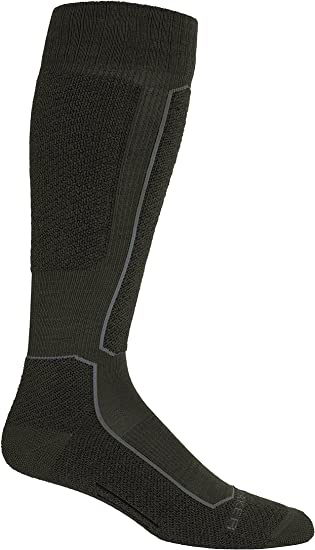
Icebreaker Ski+ Light OTC Socks
The price of “Icebreaker Ski+ Light OTC Socks” varies, so check the latest price at
2. Smartwool Ski Full Cushion Socks
You have to give Smartwool props for creativity with a name like “indestrawool.”
Apparently, this super-durable wool blend is the real deal – and that’s really important when you consider how expensive some of these socks are. At the very least, you want your ski sock to last a few seasons.
These Smartwool socks also feature a performance-oriented fit, which means that they’re quite thin and form-fitting. This is exactly what I want in a ski sock, as there’s no room for bulkiness when you’re pushing yourself to the limit.
Another thing I really liked was the fact that Smartwool makes gender-specific options for men and women. For example, the female version of this sock has a narrower heel and a slimmer overall fit.
These socks might not be cheap, but they bring plenty of features to the table.
Top Features
- “Indestructawool” merino wool blend makes for darn tough socks
- Performance-oriented fit
- Over-the-calf
- Different options for men and women
Pros
- Durable
- Thin
- Gender-specific fits
- Made in the USA
Cons
- Expensive

Smartwool Ski Full Cushion Socks
The price of “Smartwool Ski Full Cushion Socks” varies, so check the latest price at
3. Darn Tough Solstice OTC Lightweight Socks
It sounds silly, but I was immediately drawn to these socks because of the fact that they were decorated with an awesome picture of a mountain.
But as I soon discovered, these socks aren’t just about looks.
Perhaps one of the most durable options on this list, the Darn Tough Solstice ski sock is guaranteed for life. That’s right – if you buy yourself a pair, you’ll never have to replace them again.
Made in the USA, these socks feature fine gauge knitting for seriously indestructible performance.
If you like a thicker sock for a little more warmth and snugness, you’re going to enjoy wearing these babies.
Top Features
- Midweight
- Moisture-wicking
- No cushion
- Guaranteed for life
- Made in the USA
Pros
- Lifetime guarantee means you’ll never have to buy another pair
- Snug medium-weight fit
- Made in the USA
Cons
- Some might prefer thinner socks

Darn Tough Solstice OTC Lightweight Socks
The price of “Darn Tough Solstice OTC Lightweight Socks” varies, so check the latest price at
4. Smartwool Ski Targeted Cushion OTC Socks
Smartwool makes our list once again with the Cushion Pattern OTC.
The name says it all:
You can expect some pretty satisfying cushioning here, which is ideal if you tend to get sore feet while hitting the mountain.
You also get the same “indestrawool” technology that’ll stand the test of time.
Even though these smartwool ski full cushion socks offer plenty of protection, the performance fit never felt too bulky for me.
Top Features
- Solid cushioning
- Indestrawool technology
- Made in the USA
- Performance fit
Pros
- Lots of cushioning
- Durable
- Solid ventilation
Cons
- Some might prefer less cushioning
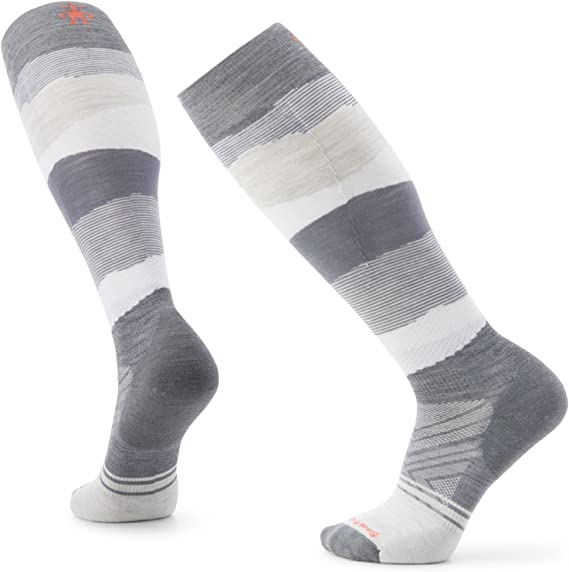
Smartwool Ski Targeted Cushion OTC Socks
The price of “Smartwool Ski Targeted Cushion OTC Socks ” varies, so check the latest price at
5. Dissent GFX Compression Hybrid Socks
I have to admit, these are one of my favorite ski socks today.
Why?
Somehow, Dissent has managed to create ultralight socks that are somehow still durable – with all the benefits of wool and none of the downsides.
This ultralight sock is completely synthetic with a mixture of lycra, Nanoglide, and Polyamide. If you’ve never tried Nanoglide before, you’re in for a treat!
After weeks of riding in these socks, I experienced no blisters whatsoever. Not only does Nanoglide protect your feet, but it’s also insanely durable despite being quite thin and lightweight.
The best thing about these socks is that they do not move around – no matter what! I never felt like I needed to adjust my socks.
Perhaps most importantly, these socks do not smell bad despite being synthetic, as they have been specially treated with anti-odor technology.
The only real downside is the price…
Top Features
- Engineered technical yarns
- Extremely lightweight
- Compression
- Low-profile padding
- Nanoglide technology
- Anti-odor treatment
Pros
- You never have to adjust your socks
- Super lightweight
- No blisters
- Great option for vegans
Cons
- Insanely expensive
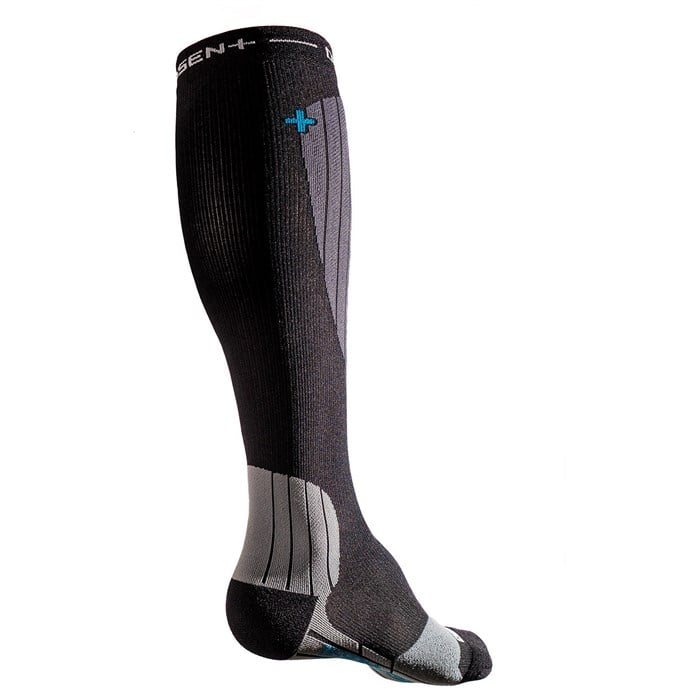
Dissent GFX Compression Hybrid Socks
The price of “Dissent GFX Compression Hybrid Socks” varies, so check the latest price at
6. EURO Socks Ski Zone Socks
If you don’t want to spend $60 on a single pair of socks (and I don’t blame you), consider the Ski Zone ski sock from EURO socks.
These socks offer solid craftsmanship, and they are 100% made in Italy – a nation known for its solid manufacturing and design prowess.
For under $20, you get solid cushioning on the sole and the shin – and I found that this really made my boots a whole lot more comfortable to wear.
Even though these socks are made from synthetic fibers, they offer solid odor control. I never felt like my feet were too stinky – which is a solid bonus.
Top Features
- More affordable
- Solid padding
- Moisture wicking
- Midweight socks
Pros
- Affordable
- Great cushioning
- Made in Italy
Cons
- Not as feature-rich as some of the other options

EURO Socks Ski Zone
The price of “EURO Socks Ski Zone” varies, so check the latest price at
7. Le Bent Le Send Pro Socks
The “Le Bent Signature Blend” is a unique mix of bamboo and merino wool – creating a very interesting and high-performance ski sock.
One of the key benefits you’ll notice right away is that the bamboo helps eliminate the itchiness that is sometimes associated with merino wool. If you like the idea of merino wool but can’t stand the itchiness, try these on.
Apparently, Le Bent and pro skier Cody Townsend worked together on these socks, and one of the key goals was eliminating blisters. After trying them on, I can’t deny that they’ve achieved their goal!
Top Features
- Used by pros like Cody Townsend
- Interesting blend of bamboo and merino wool
- Ultra lightweight
- Toe cushioning
Pros
- No blisters
- Wool but without the itchiness
- Lightweight yet warm
Cons
- A little on the expensive side

Le Bent Le Send Pro Socks
The price of “Le Bent Le Send Pro Socks” varies, so check the latest price at
8. CEP Ski Merino Tall Compression Socks
The CEP Merino Tall Compression sock is another solid choice – especially if you like the idea of a compression sock.
This sock’s compression technology can improve circulation by up to 40%. I have to admit, I did notice a difference when riding with these socks.
I just felt a little more agile – like I could actually feel the snow underneath me. These socks didn’t make a huge difference – but it was noticeable – and my feet definitely didn’t feel numb or icy.
Another solid bonus is that these socks can be used for either snowboarding or skiing, giving you tons of versatility.
Top Features
- Merino wool
- Padding to reduce blisters
- Compression technology
Pros
- Compression boosts circulation
- Merino wool is moisture-wicking
- You can use them for either snowboarding or skiing
Cons
- Not the cheapest with almost $60 price tag
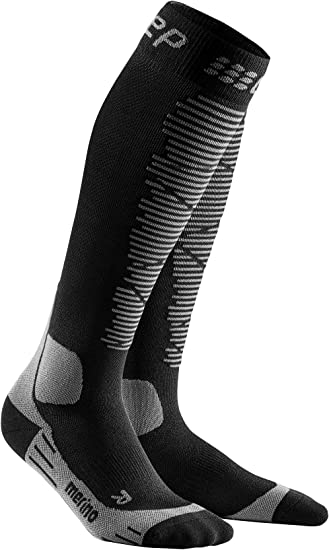
CEP Ski Merino Tall Compression Socks
The price of “CEP Ski Merino Tall Compression Socks” varies, so check the latest price at
9. Wigwam Snow Sirocco Ski Sock
With a price tag around $20 and a lifetime guarantee, it’s hard to say no to the Wigwam Sirocco Ski sock.
It’s a solid, classic ski sock with everything you need, including moisture-wicking, odor control, durability, and cushioning.
Wigwam is one of those brands that has been around for ages, and they first started making socks over 100 years ago. They also proudly make their socks in the good ol’ US of A.
For the price, these are definitely the best-value socks on this entire list.
Top Features
- Midweight
- Durable
- Wool blend wicks away moisture while providing odor control
- Lifetime guarantee
Pros
- Solid affordability
- Solid cushioning
- Lifetime guarantee means you’ll never need to replace them
Cons
- You might prefer a lighter ski sock
- Not as feature-rich as some of the other pairs on this list

Wigwam Snow Sirocco Ski Sock
The price of “Wigwam Snow Sirocco Ski Sock” varies, so check the latest price at
Is Choosing the Best Ski Socks for Your Ski Boots Really That Important?
Let’s back up and ask some very simple questions:
Is it really necessary to shop for the best ski socks?
Can’t you just grab an average pair of socks from your dresser and head up the mountain?
Well… sure!
There’s nothing stopping from using socks that aren’t designed for skiing.
The real question is whether you’re ready to experience the consequences of using regular socks instead of ski-specific socks. These include:
- Overly sweaty feet
- Cold feet
- Lack of circulation
- Wet feet
- Boots that feel too tight
- Lack of performance
- Sore feet
- Potential injuries
- Or all of the above
Yes, that’s right!
Improper socks can cause all of these issues. Take it from me:
Bad socks can absolutely ruin your day on the mountain.
Whether you’re a complete newbie or a seasoned pro, choosing the best socks for skiing is one of the easiest – and cheapest – ways to upgrade your gear and strive for that next level of achievement.
Consider the fact that even the best ski or snowboard socks are only a few dollars more than regular socks.
I mean… why wouldn’t you want to invest in comfy, warm feet?
The History of the Ski Sock
Before we dive into our buying guide, let’s take a trip back in time and ask another pivotal question:
Where the heck did socks come from, anyway?
The word “sock” actually comes from the Latin word “soccus,” which is what the Romans called a lightweight shoe specifically designed for comedians and actors.
But the first real socks appeared much earlier in Ancient Greece, and they were called “piloi.”
These were leather or fur foot wrappings that featured a very basic design. The Romans then created fabric socks for the first time, improving on the design with their new “udones.”
Although combining socks and sandals is a fashion faux pas today, there is evidence to suggest that some of the earliest socks featured a split-toe design specifically for use with sandals.
Some of the oldest-surviving sock companies have been going for well over 100 years. For example, J.B. Field’s was established in 1877 and is one of the few remaining companies that manufactures socks in Canada.
When athletes first started engaging in winter sports, various sock manufacturers began making thermal socks for the first time. However, it soon became clear that winter athletes had unique demands. For example, thermal socks may keep our feet warm – but they can also cause excessive sweat because of their thicker design.
Buying Guide: What to Look for in Best Ski Socks
Now let’s move towards the buying guide:
Materials
First of all, you’re going to have to choose your material. Many skiers swear by wool socks, but this isn’t the only option. In contrast, most skiers will tell you to steer clear of cotton socks at all costs. Why? Because cotton becomes seriously uncomfortable once it becomes wet.
And that’s true!
Cotton does pose a major issue when it gets wet.
But… what happens if cotton never actually gets wet?
The truth is that as long as you can keep your socks dry, cotton is actually one of the most comfortable and warm materials for the socks.
As long as you have good boots, your socks should stay pretty dry.
Other than cotton and wool, the only other choice is a synthetic blend like nylon-polyester.
Make no mistake – these socks have become quite advanced and popular in recent years. They may feature antimicrobial coatings and moisture-wicking technology – allowing them to mimic many of the features commonly associated with wool.
I actually prefer the feeling of synthetic socks – but that’s just me.
Fit
There are a number of factors to consider when choosing socks for skiing that actually fit. First of all, you should choose the right size. Secondly, you should choose a sock that is a little on the thinner side.
Thin socks offer a number of advantages, including:
- They allow you to “feel” the terrain more easily.
- They allow you to fit into tight, aggressively-molded boots more effectively.
- They reduce sweat.
You can also choose socks with cushioning – which might be a good idea if you’re prone to blisters and sore feet. That being said, most ski socks feature only light cushioning to help fit into boots more effectively.
Durability
The only downside with thinner socks is that they tend to break more easily. This is especially true if you are an aggressive, advanced rider.
With so much bending and flexing, your socks are bound to die eventually.
While durability is definitely something to consider, you shouldn’t worry too much about it. After all, you can always buy another pair of socks after a few months, and they’re not exactly expensive.
Price
If you’re willing to spend money on ski-specific socks, you’re probably not too concerned about the price.
However, you should at least keep an eye on the price tag – especially if you have a very specific budget you need to stick for all your winter gear.
Science Behind the Best Ski Socks: Is Merino Wool Worth It?
What exactly makes these ski socks so advanced?
What is the science behind the best ski socks on the market today?
Believe it or not, there are “sock scientists” out there who dedicate their entire lives to creating the perfect ski socks – and they’re never quite satisfied. These professionals are constantly improving sock technology, and this is what they tend to focus on:
New Fibers
The process of sock science begins with the raw materials. Some of the most advanced fibers used for modern ski socks include new lycra and nylon blends.
Moisture-Wicking Technology
“Moisture-wicking” has become something of a catchphrase in the world of ski socks – but it’s the real deal. The most advanced ski socks can transfer perspiration away from the foot, creating a dry, comfortable feel even in the most demanding environments.
Elasticity
Newer ski socks also feature exceptional elasticity, giving you a total freedom in your range of motion while simultaneously ensuring solid durability. Take it from me: You need a sock that bends with your body instead of fighting against it.
Ultra-lightweight Wool
Some of the best ski socks today feature advanced wool blends that give all the warmth with none of the bulkiness. These ultra-lightweight wool blends are thin enough to fit even in the tightest boots without any discomfort.Wool can soak up 30 percent of its own weight in moisture while still feeling warm and dry.Personally, I can’t speak too much about the benefits of wool because I tend to stay away from animal products. That being said, a lot of riders out there absolutely love wool socks and refuse to wear anything else.
Padding
When shopping for the ski socks, you’ll quickly see that many of them feature strategically-placed padding. This padding protects pressure points on your feet, making your ski days more comfortable.Sock scientists carefully study biomechanical processes to put padding in exactly the right locations. Some socks even feature padding on the shin area.
Compression
The new ski socks today often feature compression technology. This technology works to improve circulation in your feet instead of reducing it. Wear a pair of compression socks, and you’ll experience better blood flow and warmth – with the added bonus of less muscle fatigue.Some of the best compression socks even have special features that improve circulation to the toes. Personally, I’m not a huge fan of compression socks because of how tight they are – but to each their own.
Odor Control
While it won’t affect your ability to ski, foot odor can certainly pose a problem when you’re trying to make friends on the mountain. If you’ve never been skiing before, prepare for some pungent scents when you take off your socks after a full day of riding.The good news is that if you choose socks with odor-control technology, you’ll never have to deal with this problem. Most of these “odor control” socks rely on wool fibers, as you can naturally eliminate scents just by airing them out. In contrast, synthetic fibers tend to hold onto odors.
Anti-Microbial and Anti-Bacterial
Many ski socks also feature anti-microbial and anti-bacterial technology. This prevents bacteria and microbes from latching onto your feet, potentially causing things like fungal infections and other issues.Believe me: This is a real problem – especially if you’re riding or skiing for an entire week non-stop.
Ski Socks vs Snowboard Socks: What’s the Difference?
Is there a difference between ski and snowboard socks?
It depends!
There are definitely ski-specific socks out there that are carefully designed for use with ski boot.
But on the other hand, there are plenty of socks out there (including some on our list) that can be used with either ski or snowboard boots.
Many skiers prefer thinner socks because their boots are usually a little tighter than snowboard boots.
However, it’s important to note that both skier and snowboarders will veer towards zero cushion, thin, and lightweight socks when they reach an advanced level. So when you become skilled enough, you’re always going to choose the same kind of socks – whether you ski or ride.
FAQs
What Are the Best Ski Socks?
Although it might come as a surprise to many, ski socks are actually thin rather than thick. Thick socks might sound great in theory, but take it from me:
They tend to wrinkle and bunch up when you’re riding.
This can cause pools of sweat and moisture – which then freezes in very low temperatures. If socks bunch up, they can also cause pressure on areas of your feet – potentially increasing the chances of injuries.
Bunched up socks can also be really uncomfortable, and they might stop you from skiing at your top level.
That being said, some people like thicker socks – and that’s okay!
At the end of the day, you might need to try out different kinds of socks and figure out which feels best for you.
Of course, you could always go with a “medium-thickness” sock that strikes a balance between being too thin and too thick.
What Are the Warmest Ski Socks?
If you want ski socks that are as warm as possible, you’re probably going to have to reach for a pair of wool socks.
That being said, it all depends on your unique needs and requirements.
For example, a thin pair of synthetic socks might actually end up being warmer because they cause you to sweat less.
Because of the body’s temperature regulation system, you might end up sweating more in colder temperatures as you get rid of excess heat through the soles of your feet.
This may make wool socks very uncomfortable – especially during spring skiing.
At the end of the day, you might need to try out a few different pair of socks with various materials and thicknesses to determine the warmest and most comfortable socks for you.
Are Wool Socks Good for Skiing?
Wool socks can certainly be an excellent choice for skiing – but only if you choose options that are specifically designed for skiing.
Normal wool socks can be too thick and bulky to fit in your ski boots. They may also bunch up, causing discomfort and potential moisture pockets.
If you want to reach for a pair of wool socks, you should aim for lightweight fibers that are as thin as possible. You might also want to consider the quality and source of the wool. For example, Merino wool is considered the “gold standard.”
Among other things, Merino wool doesn’t itch as much as normal wool.
If you want to buy top-quality wool socks, you might also want to consider those made from New Zealand wool – as many sock experts consider this to be the best source.
But again, I can’t really speak of the quality of wool socks because I can’t remember the last time I wore a pair.
Do You Need Special Ski Socks?
No. You don’t actually need special ski socks.
You could even ski with no socks at all if you want to!
The question is whether you’ll be comfortable while ski touring.
And if you want to maximize comfort, performance, and warmth, you will need to reach for a pair of special ski socks. You can also opt for heated ski socks if you tend to feel cold in the mountains!
Personally?
I just wear a pair of old soccer socks.
Soccer socks are designed with the same basic goals in mind. They need to be thin enough to fit underneath cleats, and they are built specifically for athletes.
I’ve never had any issues with them.
Are Ski Socks Supposed to Be Thin or Thick?
Generally speaking, ski socks are supposed to be on the thinner side.
Ski socks that are extremely bulky and thick may be designed more for hiking than skiing.
And even then, hikers generally don’t like to wear super thick socks, because they can make their boots too tight.
The same logic applies to skiing.
Ski boots are designed to be very snug and close-fitting. Even a few extra millimeters of bulky sock material can make your ski boots too tight.
This is why it’s generally a good idea to veer towards thinner socks instead of thick socks.
If you have thin socks, the worst-case scenario is that your feet will be a little cold.
If you have socks that are too thick, your boots might not even fit properly anymore.
That being said, it’s really just a matter of personal preference at the end of the day.
Personally, I like to keep my socks as thin as possible.
If you have good boots, your feet aren’t going to get cold – no matter what kind of socks you wear.
It’s really that simple!
Should You Wear 2 Pairs of Socks When Skiing?
NO!
Never wear two layers of socks while skiing.
Although this might seem like the best way to stay warm, you’ll realize that you’ve made a major mistake about an hour into your ski day.
Firstly, two layers of socks will make your feet insanely bulky – and your boots might not fit properly.
Secondly, it will be almost impossible for your feet to breathe properly. You’ll start to sweat, and that moisture will stay trapped around your feet for hours.
You’ll also probably struggle with bunched-up layers that will lead to considerable discomfort and perhaps even injuries.
So yeah – just don’t do it!
Final Thoughts
Grabbing myself a new pair of ski socks is something of a ritual before each winter.
When you already have the best gear available, your socks are one of the few things you can “upgrade” before the season begins.
Ski socks also make great presents during the holidays if you know someone who loves to ski.
So what are you waiting for?
Grab yourself a new pair of ski socks today and invest in a valuable, comfortable piece of ski gear!
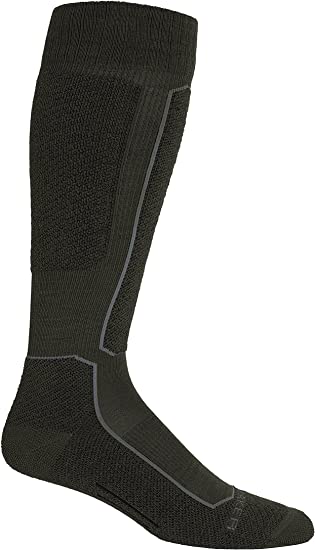
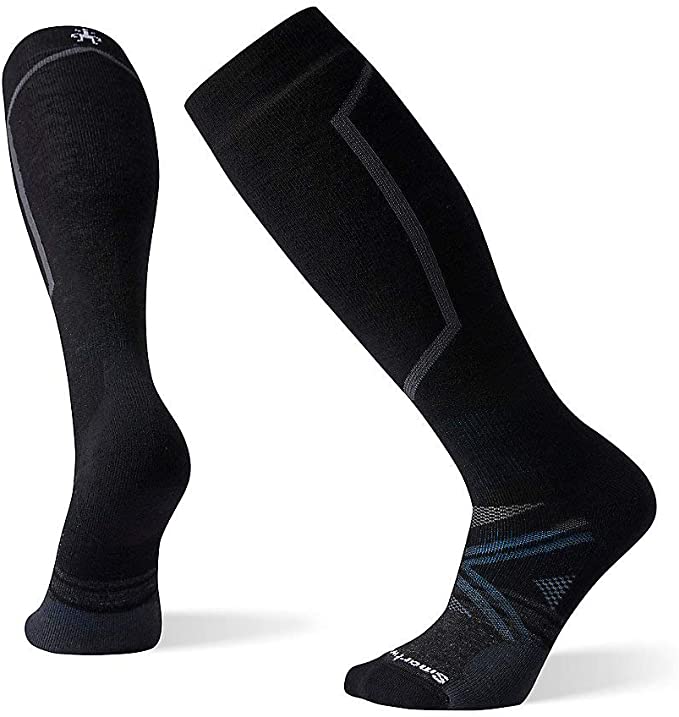
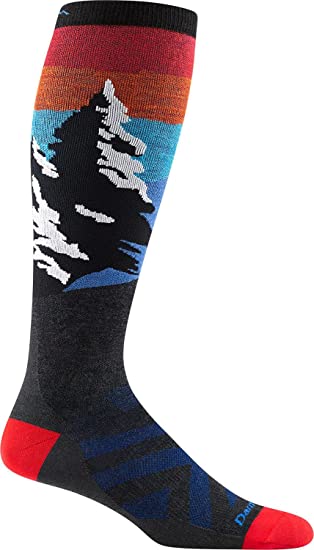
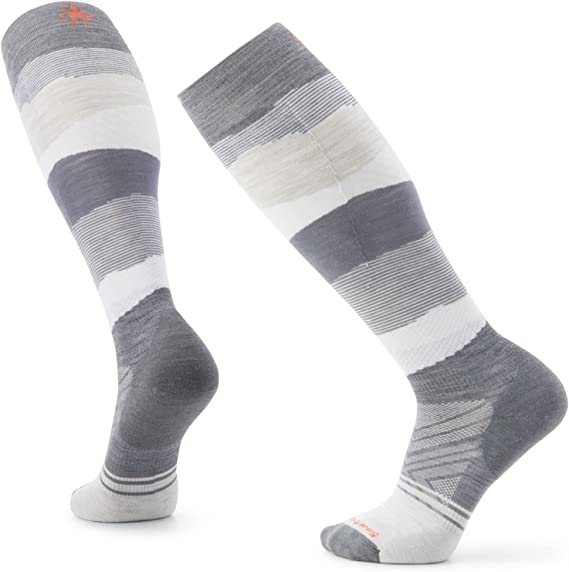
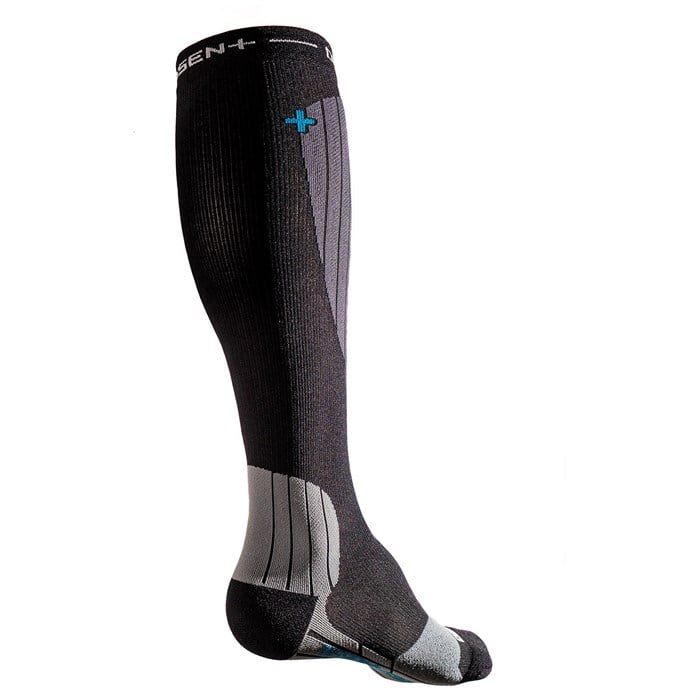
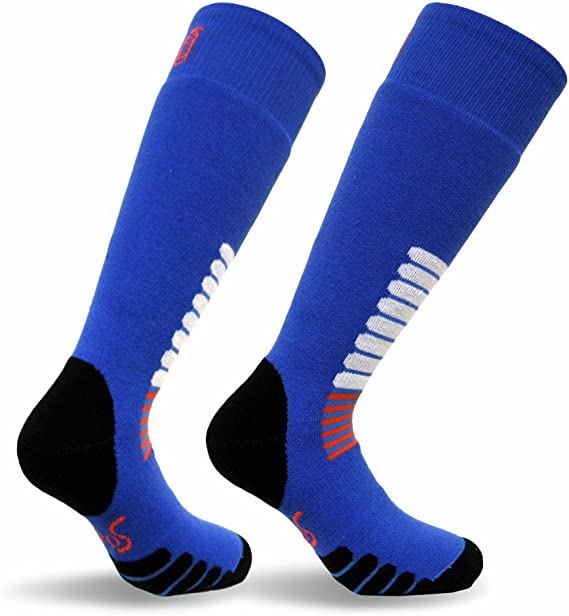
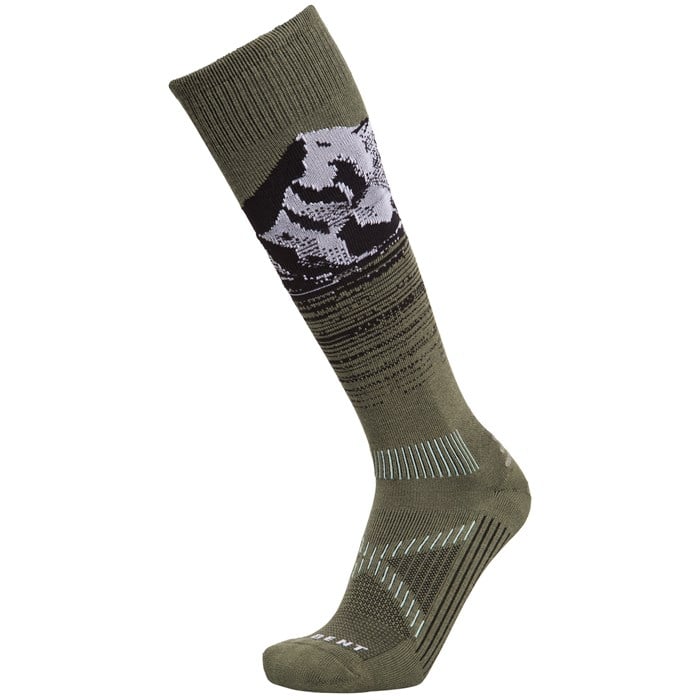
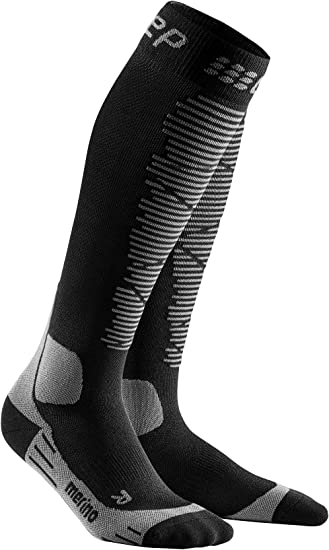
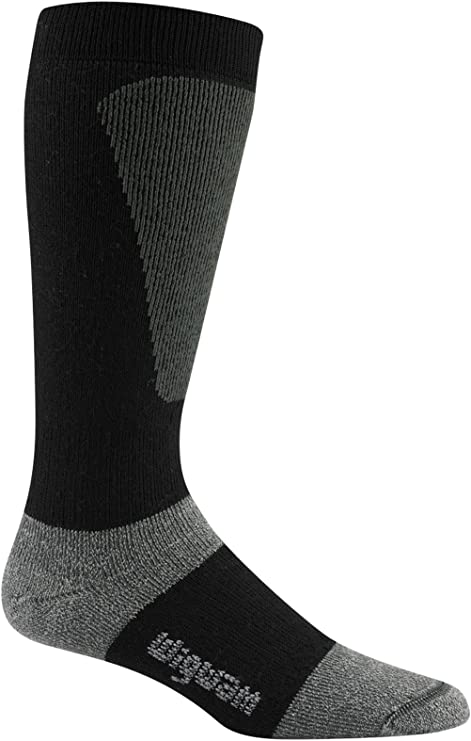
0 Comments